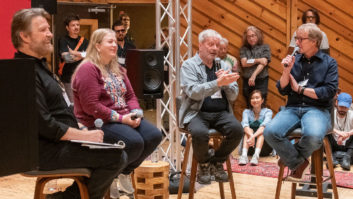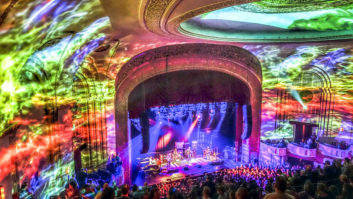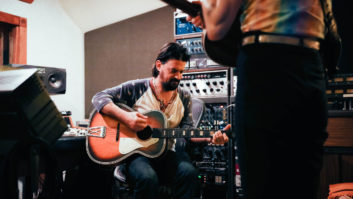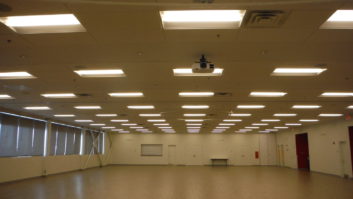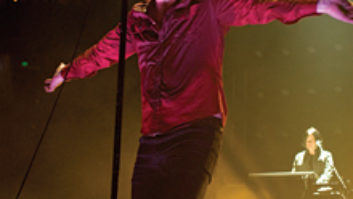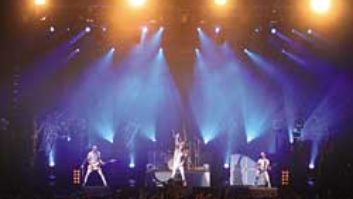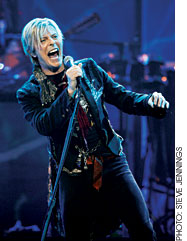
From the moment David Bowie’s band entered the stage, walkingalong a high catwalk and silhouetted against a dramatic, projectedbackdrop of the Milky Way (Bowie appearing suddenly below them, wrappedand abstracted by white beams of light), it’s evident that his Realitytour is a rock show of grand proportion.
On this January night at the HP Pavilion (San Jose, Calif.),midway through a nine-month world tour, the set list reads like aBest ofalbum. The music and Bowie’s enthusiasm areinfectious, and the audience spends much of the two-and-a-half-hourconcert on its feet dancing. A showcase for Bowie’s enduring, hauntingvocal sound and the versatility of his bandmembers, the show seguesfrom hard-hitting guitar and drum-powered songs to piano andelectronica-influenced tracks such as “Fame,” “TheMan Who Sold the World” and “Under Pressure” to songsoff of his latest CD,Reality, including “Bring Methe Disco King,” “The Loneliest Guy” and“Days.”

MEET THE CREW
Front-of-house engineer Pete Keppler and monitor engineer MichaelProwda head up the audio crew, with systems provided by FirehouseProductions (Milan, N.Y.) and Adlib Audio (Liverpool, England). Whileregularly selling out arenas, the show occasionally dipped into1,500-seaters, which meant that the system had to be scalable and themixers needed to stay on their toes.
As a studio engineer in New York City, Keppler — a musicenthusiast, part-time musician and iPod convert — previouslytoured with such singer/songwriters as Steve Earle, Aimee Mann andSuzanne Vega. He first worked as an assistant engineer in the recordingstudio and for one-off events with Bowie in 2000, and was asked to joinfull time for this year’s tour. Keppler uses a Yamaha PM1D digitalconsole, which he calls a “good-sounding, relatively bullet-proofdesk.”
“It’s totally active mixing, and for each song, theinstruments change quite a bit,” he says. “I can change thecompression and EQ; I don’t have to scramble in-between songs, I justhit a new preset. We had a lot of production rehearsals last summer,and I was really able to hear each song and solo inputs to hear howthings were fitting together and make a lot of base preset structures.I’ve been improving on it ever since.”
There are seven musicians onstage — Bowie (vocals/guitar),Sterling Campbell (drums), guitarists Gerry Leonard and Earl Slick,Mike Garson (piano/keyboard), Gail Ann Dorsey (vocals/guitar) andCatherine Russell (keyboard/backing vocals) — who, combined,require 53 inputs to FOH. Keppler handles FOH setup each day of theshow, saying with a laugh, “It’s just a preference of mine to bethe one who connects everything because if anything has gone wrong, Idon’t have to blame anyone else. It’s like a pilot knowing hisplane.”
VOCALS ON TOP
Working with a dynamic vocalist such as Bowie, who not only has oneof the most distinctive voices in the business, but also a masterfulmic technique and a preference to control his own vocal effects, it’salmost expected that his vocals would sit atop the mix. Keppler tempersthis assumption, saying, “David’s voice sits on top, but this isnot a Vegas-style show. The band is every bit as present as they needto be in the mix.”
Bowie sings into a Shure Beta 58A, switching to a Shure wirelessunit (comprising a U4D receiver matched with a U24D transmitter) whenwalking around the elevated sections of the stage during the show. Thevocal chain starts with the Focusrite Red mic pre, from which bothKeppler and monitor engineer Prowda take a line-level feed. Keppleruses two of the 24 onboard graphic EQs from the PM1D to compensate forthe wired-to-wireless transitions. In addition to using the PM1D’sonboard effects, Keppler relies on a couple of TC 3000s on vocals andselect instruments and a BSS 901 dynamic EQ. All of Bowie’s vocal micsgo through a Summit DCL200, and a touch of reverb is added to vocalsand the piano when necessary.
After experimenting with other P.A. systems on past tours, Kepplerdecided on a JBL VerTec line array, claiming that “it’s the bestrock ‘n’ roll P.A. out there. It really carries the high frequenciesfurther than other systems I’ve used.” A maximum of 14 cabinetsand subs are flown per side. Keppler takes the time to walk the houseand check every zone in every venue for the most even coverage, makinguse of a PRAM wireless tablet that was introduced to him by his systemtech, Tony Szabo. “I go into the deepest seats in the venue— up in the back row — tune the system from there and getit sounding good. Concert tickets are expensive these days. People cometo hear a show as much as to see it. It doesn’t matter where people aresitting. I want them to get the best sound they can.”
HALLO, MONITOR MAN
While Prowda has been a fixture on Bowie’s tours for almost a decadenow, he worked extensively — and just wrapped production —with the Blue Man Group before Bowie’s current tour took to the road. Arecent convert to the Yamaha PM1D, Prowda manages about 30 mixes duringthe show, a range that comprises six stereo musician mixes, 14 stemssent to Campbell’s Mackie 1402 VLZ Pro, various tech mixes and a Bowievocal send that feeds his vocal effects system. With 11 drum inputs anda variety of vocal, guitar and keyboard direct ins, Prowda relies onthe scene capability of the PM1D, saying, “Every song is a sceneand I have some 50-odd scenes.”
The Reality tour seems to be an atmosphere that encourages musiciansto experiment with and take control of their own sound: Prowda hasCampbell customizing his own mix. “He’s got a 14-channelmixer,” Prowda says. “I’m creating mix stems off of thePM1D, which includes kick, snare, hat, bass guitar, a stereo drummix-minus, DB vocal, a stereo band mix-minus, stereo tracks and click.Once my levels to the Mackie are set, he creates his own blend. It’sbeen working great.” Campbell also gets extra punch on his drumthrone through two Aura transducers. Prowda reports that there isanother drum system onstage that uses a Firehouse F15 wedge on top ofan L-Acoustics DV sub powered by L-Acoustics amps.
As for Bowie’s mix, Prowda explains that, “What sounds good tome works well for him. There’s no second-guessing. I make it sound likeI think a house mix should sound with a blend of everything.”Bowie, meanwhile, puts his focus into his vocal performance, using aproprietary vocal effects system onstage that comprises a DigitechVocalist and a Moog moogerfooger.
“These are doubler and distortion effects that go to monitorsand front of house,” Prowda explains. “David has two volumepedals onstage where he mixes his own distortion and doubling and setshis volume level. He’s hearing the balance in his head and wants it tosound similarly in the house.” In addition to onboard effects,which Prowda varies from song to song, he uses a dual-channel Focusrite8 preamp and one his favorite tools — a Summit TLA100 — onBowie’s voice.
The entire band is on in-ear monitors: Sennheiser Evolution SeriesEW300s with Westone Elite Series ES2 soft molds, which Prowda likesbecause, “These systems provide the best audio quality and stereoimaging of anything I’ve heard to date,” adding that thefrequency agility of the Sennheisers have become essential in today’smarketplace. Prowda also employs a rack of eight Aphex Dominator 2s,processing that he “can’t live without,” using it to“drive as much signal as possible into the radios.”
When it comes to miking the performers and their instruments, Prowdaselects the right mic for the job, anything from “Shure KSM32sand Audio-Technica A-T 4050s on the guitars and overheads, Shure Beta56s and 91s on snare and kick, to Sennheiser E 604s and 602s on tom andkick. I’ve got this mic that I love on hi-hat: an A-T 4041.”Backup vocals are heard through Shure Beta 58As and 87Cs.
Keppler credits his crew — Tony Szabo, Greg Lopez, Bob Lewisand John Drane — for their “expertise and ability to put upthe P.A. up in such a wide variety of venues, and making it all workflawlessly.” Keppler also notes the generosity of tour vendorowners Bryan Olson (Firehouse) and Andy Dockerty (Adlib Audio), andthanks Prowda for doing an amazing job mixing in-ears for Bowie and theband. “If David Bowie and the band weren’t able to hearthemselves as well as they do, it wouldn’t matter how well I mixed theshow. It all starts from the stage. If the band can groove with eachother, we’ll have a good show.” Prowda, in turn, can’t giveenough kudos to his supporting crew who he laughingly refers to as a“dysfunctional extended family,” which includes hisassistant, Tristan Johnson, Andrew Burns (guitar tech), Tom Calcaterra(guitar tech), Peter Danilowicz (keys and vocals effects tech), JohnWalsh (drum tech), Jeff Ousley (bass tech) and Dave MacMullan (computertech). Despite any new challenges and demands that Keppler, Prowda andcrew have to overcome during Bowie’s tour, the reaction in the standsat tonight’s show makes it evident that, Reality, as it is, isgood enough.
Breean Lingle is a Mix editorial assistant.
